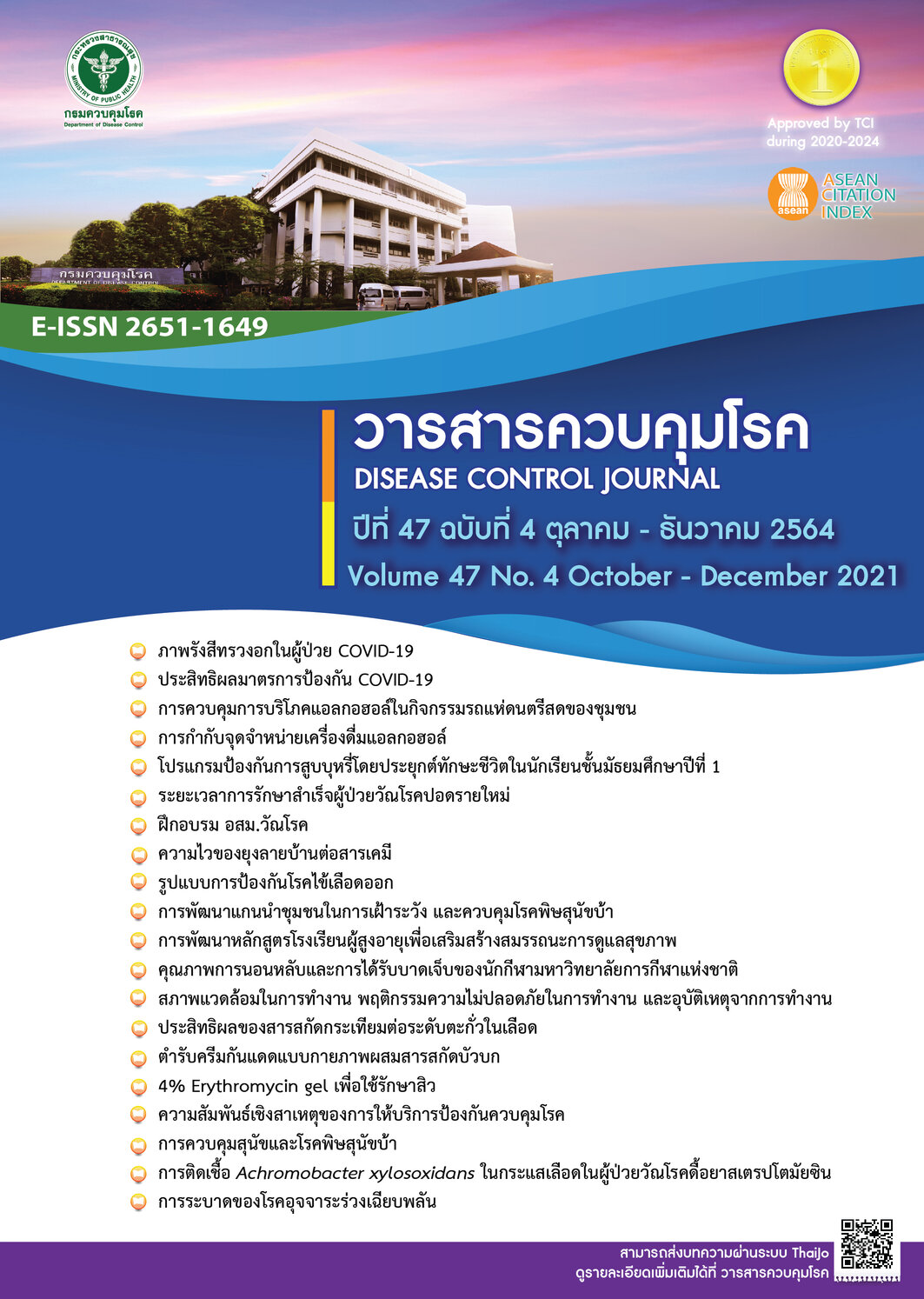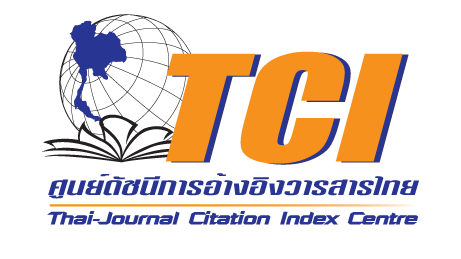คุณลักษณะความไวของยุงลายบ้านต่อสารเคมี และประสิทธิภาพของสารเคมีประเภทฉีดพ่นหมอกควัน ในการกำจัดยุงลายบ้านที่มีความต้านทานต่อสารเคมีกำจัดแมลงจากจังหวัดจันทบุรี
DOI:
https://doi.org/10.14456/dcj.2021.84คำสำคัญ:
ยุงลายบ้าน, การต้านทานต่อสารเคมีกำจัดแมลง, การควบคุมพาหะนำโรคไข้เลือดออก, การฉีดพ่นหมอกควันบทคัดย่อ
การวิจัยนี้มีวัตถุประสงค์เพื่อทดสอบความไวของลูกน้ำและตัวเต็มวัยยุงลายบ้าน (Aedes aegypti) ต่อสารเคมีและศึกษาระดับเอนไซม์ที่เกี่ยวข้องในการทำลายฤทธิ์ของสารเคมีในยุงลายบ้านจากพื้นที่หมู่ 2 ต.ปัถวี อ.มะขาม จ.จันทบุรี รวมถึงศึกษาประสิทธิภาพของสารเคมี จำนวน 8 ชนิด ประเภทฉีดพ่นแบบหมอกควันต่อยุงลายบ้านในพื้นที่ศึกษาเปรียบเทียบกับยุงลายบ้านจากห้องปฏิบัติการ (NIH strain) ซึ่งมีความไวต่อสารเคมี โดยวิธีมาตรฐานจากองค์การอนามัยโลก cage Bio-assay method ในสภาพจำลองธรรมชาติ ผลการศึกษาความไวของลูกน้ำยุงลายบ้านจันทบุรีต่อสาร Temephos ที่ระดับความเข้มข้น 0.012 มิลลิกรัมต่อลิตร พบความไวของลูกน้ำยุงลายบ้านในระดับต่ำ มีอัตราการตายเท่ากับร้อยละ 13.50 สำหรับความไวของยุงลายบ้านจันทบุรีระยะตัวเต็มวัยต่อสารเคมีทดสอบในกลุ่ม Pyrethroids จำนวน 5 ชนิด ได้แก่ Cyfluthrin 0.15%, Deltamethrin 0.05%, Cypermethrin 0.05%, Lambdacyhalothrin 0.03% และ Permethrin 0.25% พบว่ายุงลายบ้านมีความไวระดับต่ำ มีอัตราการตายที่ 24 ชั่วโมงระหว่าง ร้อยละ 0-7.80 และมีความไวระดับต่ำต่อสาร Pirimiphos-methyl 0.21% ซึ่งเป็นสารเคมีในกลุ่ม organophosphates โดยมีอัตราการตาย ร้อยละ 0 การศึกษาระดับเอนไซม์ทำลายฤทธิ์ของสารเคมีกำจัดแมลงในยุงลายบ้าน พบว่าค่าเฉลี่ยระดับของเอนไซม์ Esterase และ mixed function oxidases ของยุงลายบ้านจันทบุรีมีค่าสูง โดยมีความแตกต่างกันอย่างมีนัยสำคัญ (p<0.001) เมื่อเทียบกับยุงลายบ้านจากห้องปฏิบัติการ ในขณะที่ค่าเฉลี่ยของเอนไซม์ Acetylcholinesterase ของยุงลายบ้านจันทบุรียังคงอยู่ในระดับต่ำและไม่มีความแตกต่างทางสถิติเมื่อเทียบกับยุงลายบ้านจากห้องปฏิบัติการ การทดสอบประสิทธิภาพการฉีดพ่นหมอกควันด้วยสารเคมีในกลุ่ม Pyrethroids จำนวน 7 สูตร และสารเคมีในกลุ่ม organophosphates จำนวน 1 สูตร ด้วยเครื่องพ่นหมอกควันชนิดสะพายไหล่ ที่อัตราการใช้สูงสุดที่องค์การอนามัยโลกแนะนำ พบว่าสารเคมีทดสอบในกลุ่ม Pyrethroids สามารถทำให้ยุงลายบ้านจันทบุรีตายเพียงร้อยละ 0-6.70 ในขณะที่ Pirimiphos- methyl พบอัตราการตายของยุงลายบ้านจันทบุรีเท่ากับร้อยละ 99.7 (อัตราการใช้ 200 กรัมต่อเฮกตาร์) และมีการศึกษาเพิ่มเติมถึงประสิทธิภาพของสาร Pirimiphos-methyl ฉีดพ่นหมอกควันที่อัตราการใช้ 20, 50, 75 และ 100 กรัมต่อเฮกตาร์ พบอัตราการตายของยุงลายบ้านจันทบุรีเท่ากับร้อยละ 13.70, 41.70, 54.80 และ 97.70 ตามลำดับ เมื่อเปรียบเทียบอัตราการตายของยุงลายบ้านจันทบุรีที่อัตราการใช้ 100 และ 200 กรัมต่อเฮกตาร์ พบว่าไม่มีความแตกต่างกันทางสถิติ (p >0.05) ดังนั้นจากผลการวิจัยนี้พบว่าสาร Pirimiphos-methyl ที่อัตราการใช้ 100 กรัมต่อเฮกตาร์ สามารถเป็นอีกหนึ่งทางเลือกที่มีประสิทธิภาพในการนำไปใช้ฉีดพ่นควบคุมและกำจัดยุงลายในพื้นที่ที่มีการระบาดของโรคไข้เลือดออก โดยเฉพาะในพื้นที่ที่ยุงลายมีการพัฒนาความต้านทานต่อสารเคมีในกลุ่ม Pyrethroids
Downloads
เอกสารอ้างอิง
Alejandra MS, Jesus OV. Chemical control of Aedes aegypti: a historical perspective. Rev Costarr Salud Pública. 2013;22:68-75.
Chareonviriyaphap T, Bangs MJ, Suwonkerd W, Kongmee M, Corbel V, Ngoen-Klan R. Review of insecticide resistance and behavioral avoid¬ance of vectors of human diseases in Thailand. Parasites & Vectors. 2013;6(1):280-308.
Sirisopa P, Thanispong K, Chareonviriyaphap T, Juntarajumnong W. Resistance to synthetic pyre¬throids in Aedes aegypti (Diptera: Culicidae) in Thailand. Kasetsart J (Nat Sci.) 2014;48:577- 86.
Amelia-Yap ZH, Chen CD, Sofian-Azirun M, Low VL. Pyrethroid resistance in the dengue vector Aedes aegypti in Southeast Asia: present situation and prospects for management. Para¬sites & Vectors. 2018;11(1):332.
Isabelle D, Veronique T, Pascal G, Jean I, Romuald C, Romain G. Multiple insecticide resistance in Aedes aegypti (Diptera: Culicidae) populations compromises the effectiveness of dengue vector control in French Guiana. Mem Inst Oswaldo Cruz, Rio de Janeiro. 2011;106 (3):346-52.
Suraporn S. Mechanism of insecticide resistance to insect. Prawarun Agr J. 2019;16(1):34-48. (in Thai)
Division of vector borne diseases, Department of disease control, Ministry of public health, THAI-LAND [Internet]. 2020. [cited 2020 Oct 19]. Available from: https://drive.google.com/ drive/folders/1iWq0H64kdUDVwXaB-zQGKzXka281PVdrm
World Health Organization. Monitoring and managing insecticide resistance in Aedes mos¬quito populations Interim guidance for entomol¬ogists. Geneva: World Health Organization; 2016.
World Health Organization. Pesticides and their application for the control of vectors and pests of public health importance. Geneva: World Health Organization; 2006.
World Health Organization. Guidelines for efficacy testing of insecticides for indoor and outdoor ground- applied space spray applica¬tions. Geneva: World Health Organization; 2009.
Abbott WS. A method for computing the effec¬tiveness of an insecticide.1925. J Am Mosq Control Assoc. 1987;3(2):302-3.
Saeung M, Ngoen-Klan R, Thanispong K, Muenworn V, Bangs MJ, Chareonviriyaphap T. Susceptibility of Aedes aegypti and Aedes albopictus (Diptera: Culicidae) to Temephos in Thailand and surrounding countries. J Med Ent. 2020;57(4):1207-20.
Chareonviriyaphap T, Aum-Aung B, Ratana¬tham S. Current insecticide resistance patterns in mosquito vectors in Thailand. Southeast Asian J Trop Med Pub Hlth. 1999;30(1):184-94.
Corbel V, Durot C, Achee NL, Chandre F, Coulibaly MB, David JP, et al. Second WIN In¬ternational Conference on “Integrated approaches and innovative tools for combating insecticide resistance in vectors of arboviruses”, October 2018, Singapore. Parasites & Vectors. 2019;12 (1):331.
Satimai W. The study of using and insecticide resistant in the Eastern Thailand. J Vec-borne Dis. 2010;7:18-30.
Marcombe S, Fustec B, Cattel J, Chonephetsarath S, Thammavong P, Phommavanh N, et al. Dis¬tribution of insecticide resistance and mecha¬nisms involved in the arbovirus vector Aedes aegypti in Laos and implication for vector con¬trol. PLoS Negl Trop Dis. 2019;13(12): e0007852.
Fonseca-González I, Quiñones ML, McAllister J, Brogdon WG. Mixed-function oxidases and esterases associated with cross-resistance between DDT and lambda-cyhalothrin in Anopheles darlingi Root 1926 populations from Colombia. Mem Inst Oswaldo Cruz. 2009;104(1):18-26.
Ping LT, Yatiman R, Gek LPS. Susceptibility of adult field strains of Aedes aegypti and Aedes albopictus in Singapore to pirimiphos-methyl and permethrin. J Am Mosq Control Assoc. 2001 ;17(2):144-6.
Hilary R, Joseph B, Nongkran L, William CB. Insecticide resistance in dengue vectors. TropI¬KA.net [Internet]. 2010. [cited 2020 Oct 19];1:0-0. Available from:
ดาวน์โหลด
เผยแพร่แล้ว
รูปแบบการอ้างอิง
ฉบับ
ประเภทบทความ
สัญญาอนุญาต
บทความที่ลงพิมพ์ในวารสารควบคุมโรค ถือว่าเป็นผลงานทางวิชาการหรือการวิจัย และวิเคราะห์ตลอดจนเป็นความเห็นส่วนตัวของผู้เขียน ไม่ใช่ความเห็นของกรมควบคุมโรค ประเทศไทย หรือกองบรรณาธิการแต่ประการใด ผู้เขียนจำต้องรับผิดชอบต่อบทความของตน






